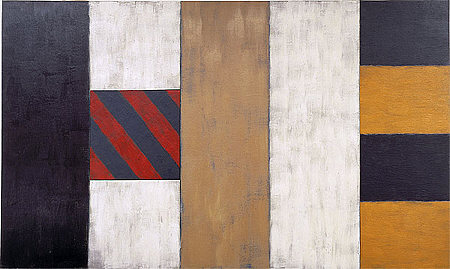
Bigland
I first stumbled upon Sean Scully in an Artnet article last year, but only a week ago did I go get some books of his work from the library. This post is about the notion of harmony and Scully’s approach to it, but I want to give a bit of context. Scully’s abstract paintings, drawings, and pastels are all based on a simplified vocabulary of stripes or short bars. This mature style developed by the early 80’s. Each painting has a different structure; the interest is partly in the composition, but more in the colors of each element — which I find lush and restrained at the same time — the and masterful way they are joined and coordinated.
That’s it for the introduction. If you want to know more, you can read the brief Wikipedia entry or check out the Body of Light exhibit at the National Gallery of Australia or his work at the Met.
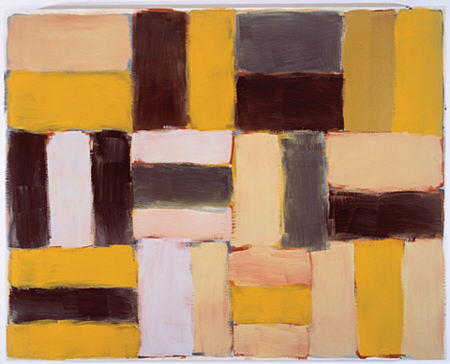
Wall of Light Beach
An unusual aspect of Scully’s oil paintings is that they are often made of separate panels joined together. They may fit tightly into a flat rectangle, or they may be layered in the third dimension and/or make an irregular outline in the plane. This feature is related to Scully’s ideas on integrity and harmony, which I found fascinating. Below are a few quotes on these ideas, taken from interviews or writings.
The pieces are generally painted separately. And sometimes they’re painted in different rooms. And sometimes they’re painted with tremendously long periods between them. So I’m not thinking about the whole, when I’m painting the pieces. I’m thinking about the pieces, what they are. And when you paint at different times, you feel differently, you are different; so that the spirit in the panels, the spirit in the pieces is different from part to part. So the paintings become emotionally dimensional. That’s my intention.
Harmony is coming out of what you know. It’s affirming what you already know. And as Einstein said, ‘when I know something, I don’t have to think about it.’ So disharmony is much more interesting and life affirming than harmony, because disharmony eventually, through history, we change into harmony.
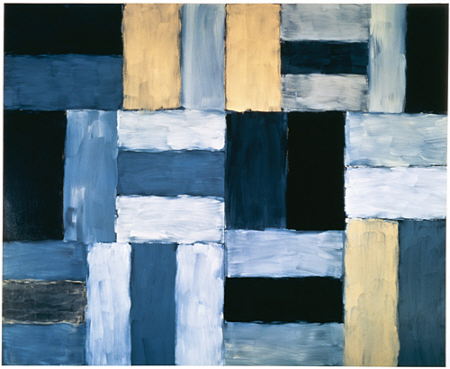
Wall of Light Desert Night
I put the things in competition with each other. So that, instead of trying to paint a relationship, I paint the areas and put them together and that makes a relationship, that is a relationship. But the relationships are not completely controlled or they’re not completely articulated. … It’s as if things are together, but they also have the possibility of asserting their independence from each other.
I reacted against the idea of perfection and of the holistic masterpiece. I wanted to make realities that were much more humanistic, where the problematic relationships between things could make a new kind of spirit and beauty. I am not trying to make masterpieces that are resolved. I want my paintings to express the pathos of relationships.
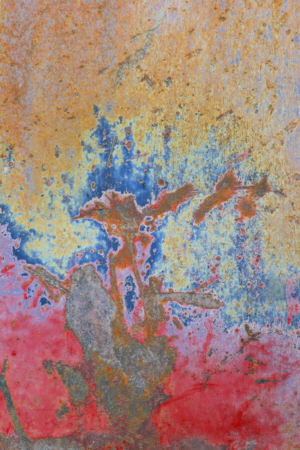
This process of deliberately bringing together potentially discordant or conflicting elements is basic to Leslie’s Hello Kitty series, which she has posted on here and here. Thinking of my own work, the only thing that comes to mind are my Patina series based on junkyard cars or weathered rocks (posts here, here, and here). Usually I am emphasizing just the abstract color design, but sometimes I include elements that tell you of the mechanical construction or of the three-dimensionality of the surface.
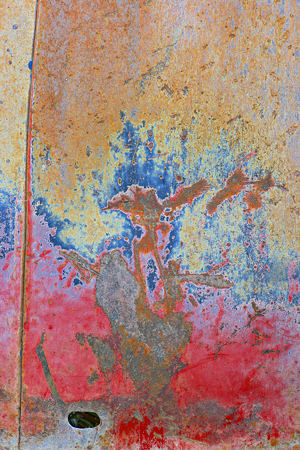
On the surface at least, deliberate introduction of disharmony seems counter to classical notions of art. But I wonder to what extent that’s true. Certainly the idea of the importance of tension among elements in a painting, say, is not new. Is Scully’s method just his personal way of achieving this? At the least, it seems that giving up fine and final control of the relationships is a modern conception.
Does any of your artwork involve playing with disharmony? Scully’s specific technique would seem to be especially adaptable to fabric art, or various kinds of assembly art.

Not sure what to make of Sean Scully. I skipped the big retrospective of his work when it came to Cincinnati because his paintings left me cold. Maybe it’s time to re-evaluate. I do like your photos you posted here, Steve. I find them more interesting and expressive than the Scully paintings.
I feel the ’emotional dimensionality’ in the bar pictures with the different panels ranging from light to dark and bright to subdued. It is easier for me to look at these first two pictures. The last pictures engender a fear of dissolution.
For me, going from disharmony to harmony seems a natural progression. Before I liked Mozart, I had to go through my Bartok period.
Tree,
I find myself not exactly taken, but more just intrigued by Scully at this point. I do find much of his work appealing, but I feel I have to learn a lot more about it and see its development to appreciate and understand individual pieces better. I’ll probably post more about him in future.
Birgit,
That’s unusual about your musical progression. Most people, I believe, have to learn to like more classical music before they develop a taste for greater variety and dissonance. I’m more or less at the point that I like Scarlatti for piano a lot. I can’t believe it’s a couple centuries old. Not sure I’ll ever make it to Bartok.
Steve,
My ‘Sturm and Drang’ period was 30 yrs ago when I heard, sitting in a front row, a Hungarian Orchestra playing his pieces. The violinists were breaking strings and perspiring. It was awesome.
Steve,
This idea of assembling art work from pieces is essentially the same as putting together an exhibition of paintings or any type of artwork. This was why I as arguing earlier that dealers are artists, their medium is art.
Disharmony can be another word for drama, I guess. Seeing it that way, without disharmony, an exhibition would be dull.
Steve:
Thinking early Frank Stella and Robert Motherwell.
Seen one or two Sean Scully paintings and what struck me – to the extent that I was struck – was their workmanlike nature. I grew up with a lot of patchwork colors in such places as the water tanks at the air base and the badges and insignia that adorned the aircraft, and his work rings that kind of a bell. It seems that they fill some flag-like identifying or signifying role.
There’s the harmony of gentle coexistence and the much more dynamic harmony of resolved differences. Many nineteenth century representational painters employed strong contrasts around the center of their images. The Impressionists countered this visual percussion with a more diffuse effect. But you can see the sense of contrast in early Monet and definitely in Cezanne’s younger – and some more mature – work.
Personally, I have big scrap rate in my endeavors. This is largely due to a need to amp up the effects – disharmonies if you will – beyond my capabilities to make them work together.
This site is terrific. An actual dialogue. About Art. I am fascinated.
The discussion about harmony really helps as an artist who struggles with that issue daily. Mostly in video and film. And with Outside Voices that keep telling me to be harmonic and pay attention to composition and I have tried.
Your words facilitate an internal dialogue about what I do and where I want to go.
For a long time, it really bothered me that as an artist nothing I do is in harmony with a single thing in the entire universe and I am not kidding. Nothing.
And I have always seen Other Artists seeking, working for harmony and that is fine. Last night I was fifty-some-odd stories above Tokyo and looking down. There was an illusion of harmony from that perspective. But I know (having been in those seething crowds) it’s an optic-fantasy and a dance of light and color and it’s a controlled chaos down there. It’s a chaos I rather love. The coming and the going and the complete inability to really fathom what might happen in the next moment. That is my journey, too.
So it’s no accident that this is where my Art goes. The sparkling lights and the neon glow tells me something, too, about particle physics and the universe. That Big Thing out There. That Zen of ying and yang and violence and vacuum. Those roads like arteries in my arm. Blue and blood and flowing usually somewhat hot.
So I’m making my videos jump from one sun to another and sometimes through one sun to another ten. It’s not right. It’s not wrong. It simply is. The particles split and warp and converge again and pass through planets and burn in furnaces far beyond the limited gravitas of our understanding. That’s a Big Stretch for Art but it’s what I want my work to do even if the New York Times wonders: But is it real.
What is real. What is something now will be something else in the particle universe and nothing is forever. Not harmony and not our comprehensions of the patterns within its structures.
But what is it about. I could not tell you what my work is about. Some of it is a mirror and some of it just flies away. But none of it is harmonic and none of it works together and what I am interested in is a focus on the space between the constituent parts that binds or pulls away. It is never static, never peaceful; it’s agitated and the real struggle is to let that just be and to stop trying to make it work as a whole because it has its own whole and destinations I can never really know.
Wow, Tim, hell of a statement. Having been in Tokyo and been a physicist, your vision of the connectedness of where you are right now was quite powerful for me.
When we think about making something harmonious, it’s often about actively trying to make something match an idea of order or balance. But I suspect there’s also a kind of organic harmony that comes with less awareness just because there’s a human consciusness recording or assembling or creating whatever (call it art) we’re talking about. You may try to let be the agitation and struggle, but I think that means a way of turning “control” over to your sub-conscious mind, which is still filtering in many ways.
I’m not trying to argue with what you say, just understand it for myself. Does that make sense?
Jay,
Good intuition about Stella, he was an important influence on Scully, who did some similar work with very narrow, parallel lines in his early days.
Love your phrase “scrap rate.” How can you know where you want to be unless you go past it (at least sometimes)? In my photo work, I almost always take something too far; fortunately, it’s easy to back off on the effect when it’s bits rather than brushstrokes.
Steve:
If only brushstrokes.
Funny about the Stella thing. I visited the newly reopened Akron Art Museum today and had a good look at their Stella. Unfortunately there is no Scully in the collection, else I could have schlepped one to the other. Suffice to say that the Frank in question seemed to be singing another song, but I’m beginning to wonder if he isn’t somehow, influencing me in the chain stuff.
I’m constantly agog over the backgrounds of those assembled here. There have to be at least three working scientists in our midsts.
Which leads me to ask what kind of a physicist you may be.
Tim:
Just had to Google and I saw interesting videos on U-Tube by a person of your name. The cadence of narration reminded me of your comment. Am I experiencing false positives?
Jay,
Mostly I was a biophysicist, but early on I did optics (laser-related stuff) and towards the end materials science (growing crystals and composites of weird stuff). It definitely informs my perspective on the inanimate world.
Steve:
You ought to be the one working on these chains.
Steve,
I am fascinated to find out you are a physicist. May the art world be further enriched by your contributions…
I love it when non-artists enrich the world of the arts… Not too sure if the BFAs and MFAs of the world would agree with me on that though…